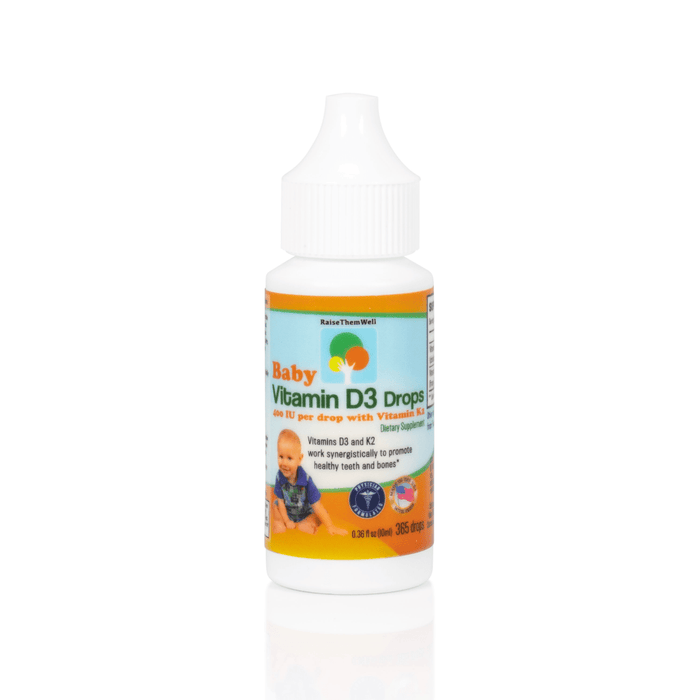
Raise Them Well Baby Vitamin D3 and K2 Drops for Ultimate Bone and Teeth Health - 365 Drops
- PHYSICIAN FORMULATED. Synergistic blend of Vitamin D3 and K2 for optimal bone and teeth health.* Controlled Dropper Tip for Precise, 1-Drop Dosing. 400 IUs of Vitamin D3 per Drop. 365 Servings (0.36 fl oz/10 ml))
- SUPERIOR INGREDIENTS. Vitamin D3 from lanolin (sheep's wool), Vitamin K2 MK-7 from K2Vital (flower extract), Non-GMO coconut and palm oil as the base.
- EASE OF USE. Controlled Dropper Tip for precise, 1-drop dosing. No more messes.
- PHARMACEUTICAL GRADE, BPA-FREE BOTTLE. Same dropper used for medicated drops.
Only Baby Vitamin D3 Drops with Vitamin K2. There is convincing evidence that Vitamin D3 needs to be combined with Vitamin K2 for maximal benefit. Without Vitamin K2, Vitamin D3 may be doing little for proper bone and teeth development.
Physician and Mom Team Developed This Vitamin D3+K2 Combination Because They Couldn't Find One For Their Children. They used only the best ingredients: Vitamin D3 from Lanolin, Vitamin K2 MK-7 from flower extracts, and Non-GMO coconut and palm oil.
Not Only That, They Also Wanted Something That Was Easier to Use With Squirmy Kids. So, they used a pharmaceutical grade dropper bottle with controlled dropper tip so that you can be confident that you are only going to get one drop at a time.
Please Do Your Research and Choose Vitamin D3 with K2 for Your Baby.
1. What is the optimum level of Vitamin D for kids?
The American Academy of Pediatrics recommends a daily dose of 400 IU of Vitamin D liquid for infants.
2. How can I find out my baby’s Vitamin D levels?
Studies have shown that about 1 in 10 children are deficient in Vitamin D, and there are often no associated symptoms. As a result, the American Academy of Pediatrics recommends a daily Vitamin D supplement for all infants, especially those that are breastfed.
3. When is the best time to give my baby Vitamin D3 and K2 Drops?
Consistency is key, so administering drops at the same time of day makes it an effortless part of your daily routine. In addition, our convenient dropper bottle makes delivery of the correct dose fast, reliable, and easy.
4. How long to give Vitamin D drops to a baby?
We recommend taking Vitamin D supplements throughout life - from infancy through adulthood - as part of a healthy lifestyle because Vitamin D deficiency affects most children and adults. You can adjust the dosage as your child grows to meet their increasing nutrient needs.
5. Is Vitamin D3 better with K2?
Yes. Taking Vitamin D3 with K2 is best for safety and maximum health benefits. Here's how these supplements work together for optimum health: Vitamin D3 makes it easy for our bodies to absorb calcium, and Vitamin K2 (MK-7) helps the calcium integrate into our bones while preventing excess calcium from clogging our arteries.
6. How many Vitamin D3 and K2 drops per day for baby?
We recommend one drop of Vitamin D3+K2 liquid per day for infants.
7. How to give Vitamin D3 and K2 drops to baby?
There are several options for administering Vitamin D3 + K2 liquid: Before feeding, place a drop onto the nipple of a bottle or breast if breastfeeding, or add it to your baby's bottle. As your baby gets a bit older, you can also place the drop directly onto the tongue.
8. Can Vitamin K2 be harmful?
There are no known side effects to Vitamin K2, but like any medication, you should take it as recommended and consult your healthcare practitioner with questions.
Please see the Supplement Facts tab for a full listing of the Ingredients in this product. In summary, it contains: Vitamin D3(cholecalciferol), Vitamin K2 MK-7 (from K2Vital@).
Articles
Since It’s Summertime Do This For Your Kids NOW
Summer is almost here (a few days away from when you’ll receive this email). With the summer comes a time for kids to get outside more than usual. That’s a good thing not just for us parents who want to enjoy a few minutes away from our children (we love them, but playtime outside is a blessing too), but for kids too...
Just One Bottle a Year for Your Child's K2 and D3 Needs
Here’s a simple reminder. As parents and grandparents, your children rely almost entirely on YOU to remain healthy. Yes, it’s a lot of responsibility, and our goal isn’t to shame you or guilt you into anything. Instead, it’s to remind you that you have a pretty significant chance to shape the lives of your loved ones...
If Your Kids Won’t Eat These - They Need This
Children aren’t known to be the most adventurous eaters. Who can blame them? Once they’ve had a taste of a sugary, sweet treat (like a fruit bar, or apple sauce), why would they want to eat something like kale? Because children have such a wide array of food choices to choose from…
I Wish More Parents and Grandparents Realized This
Before I dive too deep into this topic, please understand something. I didn’t write this email to guilt trip anyone. Imparting guilt on my readers is never my desire, I only want to make sure people have all the tools and as much information as needed to help lead healthy lives...
Why Your Babies and Toddlers Need Vitamin D and K2
As an Integrative Medicine physician, I am always looking for ways to improve the underlying health of my patients. I do not like to wait for diseases to develop before starting treatment; I like to set the stage for the body to be healthy...
The Mom Side: Droppers
I don’t know about you, but I often feel like the people who created those medicine droppers for children’s medicines and supplements clearly never had kids. I mean- how am I supposed to hold my baby while...
Don’t Let the Pretty Bottle Fool You
I’ve mentioned before about the lack of regulation and standards in the personal care products industry, but I think it’s really important to keep talking about it. Unfortunately, too many families trust products as safe...
Supplement Facts

Other Ingredients: Non-GMO MCT Oil from Fractionated Coconut and Palm Oil
DIRECTIONS:
Infants and Children - Place one drop daily onto mother's nipple, pacifir, or bottle nipple. Allow baby to suck for at least 30 seconds. You may also mix one drop daily with milk, juice, or other food once the baby is eating solid food.
Do not exceed recommended daily dose unless advised by your health care professional.










